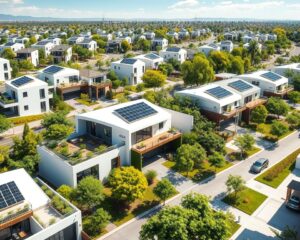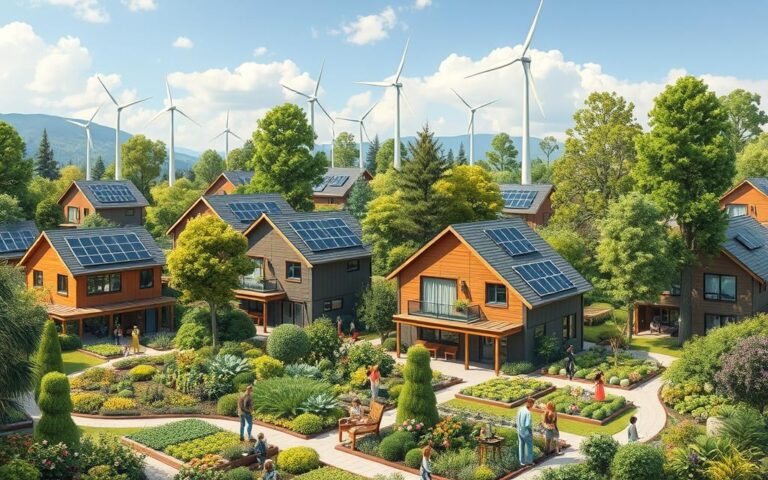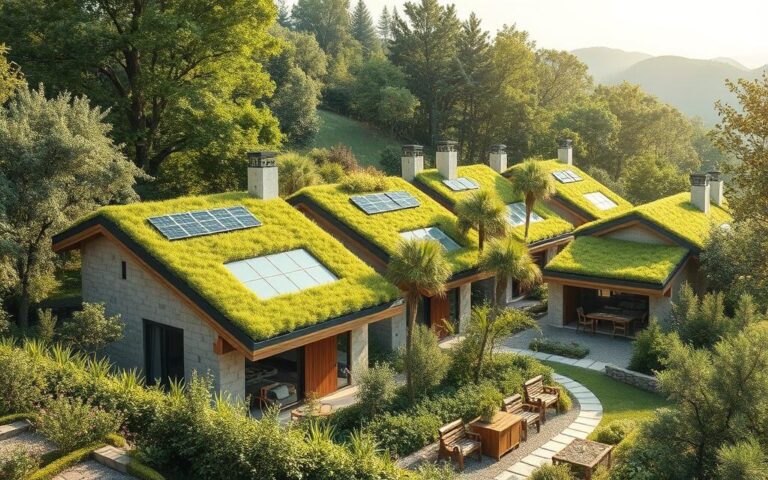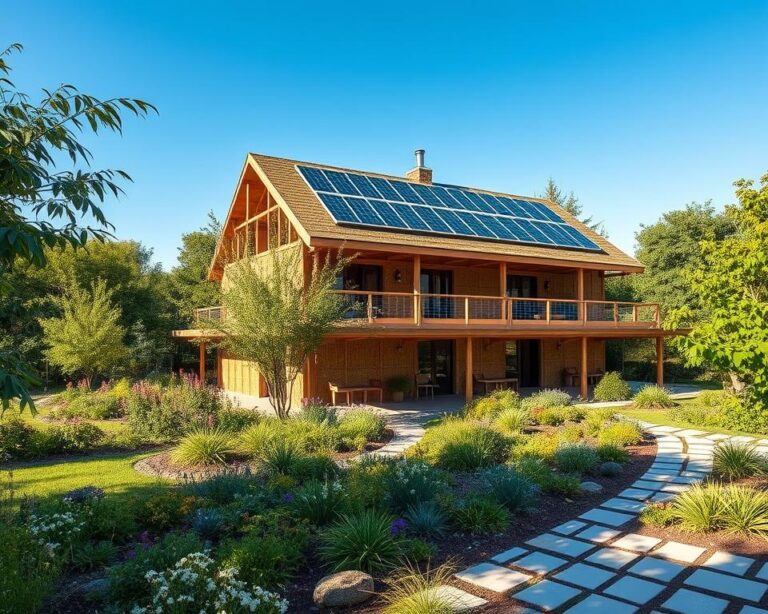Did you know over 40% of global carbon dioxide emissions come from real estate? This shows how urgent it is to make housing more sustainable. Net-Zero Homes, which use as much energy as they make, are becoming more popular. They are a big step towards a greener future, showing us how to live better for our planet.
More people want homes that save energy, showing a clear trend. Net-Zero Homes are a smart choice for now and the future. They help us live in harmony with our environment. Let’s dive into what makes Net-Zero Homes so important for a sustainable life.
What Are Net-Zero Homes?
Net-Zero Homes are a new way to live sustainably. They use the latest building methods and renewable energy. These homes make as much energy as they use in a year, making them energy-independent.
They use special materials like Insulated Concrete Forms (ICFs). These materials help keep the home warm in winter and cool in summer. This helps reach the goal of zero-energy housing.
Definition and Key Concepts
Net-zero housing focuses on being green and saving energy. A net-zero home makes its own energy and cuts down on harmful emissions. Important parts of this design include:
- Renewable Energy Sources: Solar panels and wind turbines help use less non-renewable energy.
- High-Performance Insulation: ICFs and other materials cut down heating and cooling costs by up to 40%.
- Energy Management: Smart energy plans keep these homes running well all year, meeting green building standards.
Benefits of Going Net-Zero
Choosing a net-zero home has many benefits. These include:
- Cost Savings: Homeowners can save about USD $1,635 a year on energy bills.
- Environmental Impact: Net-zero homes cut down on greenhouse gas emissions, helping fight climate change.
- Improved Indoor Air Quality: Their design keeps air out, making homes healthier to live in.
How Do Net-Zero Homes Work?
Net-zero homes use a mix of energy production and efficiency to balance their energy use. They aim to have a net zero energy bill. This shows their key role in sustainable living.
Energy Production
Net-zero homes often use renewable energy technologies like solar panels. These panels make electricity that powers the home. They can even send extra energy back to the grid, earning credits for homeowners.
Energy Efficiency Measures
Net-zero homes also focus on using less energy. They have high-performance insulation, energy-saving windows, and LED lights. These features help use less energy. Advanced HVAC systems, like air-source heat pumps, also help make them more efficient. This mix of design and technology makes net-zero homes stand out.
| Feature | Description |
|---|---|
| Energy Production | Utilizes renewable energy technologies such as solar panels to generate electricity. |
| Energy-Efficient Windows | Windows designed to minimize heat loss and maximize natural lighting. |
| LED Lighting | Uses less energy and lasts longer than traditional lighting options. |
| High-Performance Insulation | Reduces heating and cooling costs by providing superior thermal protection. |
| Advanced HVAC Systems | Heating and cooling systems designed to optimize energy use, such as air-source heat pumps. |
The Importance of Energy Efficiency
Understanding energy efficiency is key for sustainable construction and eco-friendly living. It helps cut down energy use, benefiting the environment and your wallet. By using energy-saving practices and tech, homeowners can greatly reduce their carbon footprint. This helps fight climate change.
Impact on the Environment
Buildings are a big source of carbon pollution, making energy use in homes very important. Using Energy Star appliances and materials like Insulated Concrete Forms (ICFs) can lower energy use a lot. Adding occupancy sensors and energy-saving lights, like CFLs and LEDs, also helps manage energy better, especially in commercial spaces.
Cost Savings Over Time
At first, energy-saving features might seem expensive. But, they can save a lot of money in the long run. For example, making a home zero energy can save about two dollars for every dollar spent. This means homes can pay for themselves in three to seven years.
In California, aiming for all new homes to be net-zero by 2020, many homeowners are already saving on bills. They’re living more energy-consciously.
| Technology | Energy Savings | Long-term Benefits |
|---|---|---|
| Energy Star Appliances | Use less energy than regular appliances | Lower bills and less environmental harm |
| High-Performance Insulation | Reduces heating and cooling costs | Cost-effective and good for the planet |
| LED Lighting | Uses 75% less energy than old bulbs | Long life means fewer replacements |
| Occupancy Sensors | Prevents waste of energy | Makes energy use more efficient |
Key Features of Net-Zero Homes
Net-zero homes have key features that set them apart. They focus on being energy efficient and sustainable. This supports eco-friendly living and helps create carbon-neutral properties. Knowing these features can show you the many benefits of a net-zero home.
Insulation and Building Materials
High-quality insulation is crucial for net-zero homes. It helps keep energy in. Here are some important points:
- Walls: Walls that are 6 inches thick, with foam insulation, cut down on energy loss.
- Windows: Energy Star windows keep heat in, reducing energy loss.
- Materials: Using sustainable materials like engineered wood and low-VOC paints makes homes healthier.
These features help keep energy in and support sustainable building. This makes net-zero homes attractive to those who care about the environment.
Renewable Energy Technologies
Renewable energy is key for net-zero homes. Here are the main parts:
- Solar Panels: Solar panels power lights, heating, cooling, hot water, and appliances.
- Heat Pumps: Heat pumps are efficient for heating and cooling.
- EV Ready: Net-zero homes have plug-ins for electric vehicles, encouraging eco-friendly living.

These renewable energy technologies help homes be energy independent. They also lower each home’s carbon footprint. As renewable energy improves, net-zero homes will become more common in sustainable housing.
Design Considerations for Net-Zero Homes
Effective design is key for net-zero homes. It blends functionality with sustainability. Using passive solar design, you can use the sun’s energy to keep your home warm or cool. This approach is crucial for eco-friendly homes, saving energy and helping the planet.
Passive Solar Design
Passive solar design uses natural sunlight wisely. It involves choosing and placing windows, using thermal mass materials, and insulating well. Here are important points to remember:
- Solar orientation: Place your home to get the most sunlight on south-facing windows.
- Thermal mass: Use materials like concrete or brick to absorb and store heat.
- Overhangs: Design roof overhangs to block summer sun and let winter sun in.
Layout and Orientation
The layout and orientation of a net-zero home are crucial for energy efficiency. A good design looks great and saves energy:
- Natural ventilation: Arrange windows and doors for better airflow, cutting down on cooling needs.
- Room placement: Put bedrooms away from heat sources to save energy.
- Landscaping: Use trees and shrubs for shade and wind protection, saving energy.
Making sustainable choices in design is key to net-zero status. By focusing on passive solar design and smart layout, you create a home that’s good for the planet.
| Design Aspect | Benefits |
|---|---|
| Passive Solar Design | Reduces energy costs, enhances indoor comfort, lowers carbon footprint |
| Orientation | Maximizes natural light, improves energy efficiency |
| Effective Layout | Encourages natural ventilation, minimizes heat loss |
The Role of Renewable Energy
Using renewable energy in home design is key to reaching net-zero energy use. Homes that use renewable energy mainly rely on solar and wind power. This choice helps homeowners make clean energy and lessen harm to the environment.
Solar Panels
Solar panels are a top choice for net-zero homes. They turn sunlight into electricity, helping homeowners use as much energy as they make in a year. Using solar energy cuts down on carbon emissions and fights climate change.
It also saves money on energy bills. Plus, you might make money by selling extra electricity to the grid.
Wind Energy Solutions
Small wind turbines are another great option for renewable energy homes. They help homes be more energy independent, especially where winds are steady. Wind energy works well with solar panels, boosting energy production and sustainability.
By using both solar and wind, homeowners can reach their goal of net-zero energy use. This makes their homes more eco-friendly.
Financial Aspects of Net-Zero Homes
Thinking about net-zero homes? It’s important to know the financial side. The cost might seem high because of special materials and green tech. But, the financial benefits of net-zero homes show up later. You’ll save a lot on energy bills and get financial help.
Initial Costs vs. Long-term Savings
Net-zero homes cost more at first than regular houses. This is because of new tech and materials. But, you’ll save a lot in the long run.
For example, every dollar spent on making a home net-zero can save two dollars on energy. With better insulation and windows, you’ll save money in three to seven years. You’ll also have a more stable indoor temperature.
Incentives and Tax Credits
There are many ways to get financial help. The Residential Renewable Energy Tax Credit gives a 30% tax credit for solar homes from July 2024 to December 2034. The Inflation Reduction Act also increased the tax credit cap to $5,000 for homes that meet certain standards.
Local utilities offer rebates for energy-saving upgrades like LED bulbs and smart thermostats. Some incentives go to buyers, while others help builders. For the latest info, check the Database of State Incentives for Renewables and Efficiency (DSIRE). Always read the fine print to get the most from tax incentives for green building.
Choosing the Right Location
Finding the right spot for net-zero homes means knowing how the environment affects energy use. The local weather and community resources are key. Design needs vary by region, so it’s crucial to consider the local climate to boost energy production and cut down on climate impact.
Climate Considerations
The climate affects how well your net-zero home works. For example, places with lots of sun are great for solar panels. In colder areas, homes should face east-west to catch more sun. Important things to think about include:
- Micro-climate analysis: Knowing about sunlight, temperature, and humidity helps design your home.
- Prevailing winds: Checking wind patterns helps cool your home better, making it more energy-efficient.
- Obstructions: Make sure the area is clear of buildings or trees that might block sunlight or solar panels.
Doing a detailed solar analysis of the site is very helpful. It sets the stage for efficient heating, cooling, and ventilation all year.
Community Resources
Choose a location with a community that values the environment. Having access to resources and networks can help you reach net-zero. You’ll get benefits like:
- Shared knowledge: Neighbors who care about energy efficiency can share tips and tricks.
- Local initiatives: Join community programs that support green living, backing up your home’s eco-friendly goals.
- Access to rebates and incentives: Places with green programs often help pay for solar panels and energy-saving upgrades.
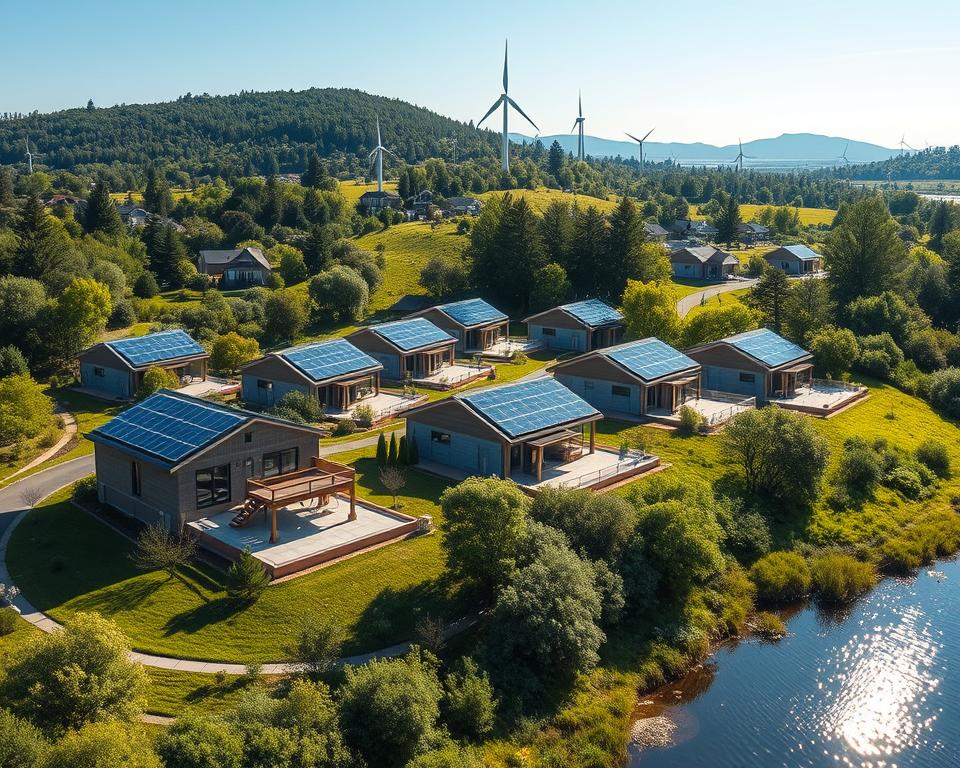
Building Your Own Net-Zero Home
Building your own net-zero home is an exciting journey. It requires careful planning and innovative design. You need to integrate energy-efficient features and focus on sustainable construction.
Working with professionals who care about the environment is key. They help you create a home that meets your energy needs. This way, your home will have a smaller carbon footprint.
Planning and Design
The first step is to analyze many factors. You need to look at site conditions, energy needs, and the best materials. Using passive solar strategies, efficient insulation, and renewable energy is crucial.
These elements help your home use renewable sources. This reduces the need for outside power. It’s a big step towards a sustainable home.
Working with Contractors and Builders
Finding experienced contractors and builders is vital. They should know about sustainable construction and energy efficiency. This partnership leads to creative solutions.
They can suggest energy-efficient materials and advanced technologies. When they know how to build net-zero homes, the project is done right. This benefits you and the environment in the long run.
Upgrading Existing Homes to Net-Zero
Turning your home into a net-zero home is possible. Over 80% of buildings will still be around by 2050. Making your home more energy-efficient is a great way to help the planet. First, you might need an energy audit to find where you can save energy.
Energy Audits
An energy audit is key. It helps you see how much energy you use and where you can save. You might find:
- Insulation that needs improvement.
- Old lighting that uses too much energy.
- Chances to add solar panels.
Retrofitting Solutions
After your audit, it’s time to make changes. You can:
- Improve insulation with recycled foam panels.
- Switch to LED lights for less energy use.
- Get heat pumps for better heating and cooling.
- Move to electric systems for zero net energy.
- Choose appliances that use less energy.
These changes can make your home energy-neutral. The Clean Energy Connection can help you find the right contractors in California. They can make sure you get the best deals for your upgrades.
| Retrofitting Solutions | Benefits |
|---|---|
| Insulation Improvements | Enhanced thermal performance and reduced energy waste. |
| LED Lighting | Significant energy savings over traditional bulbs. |
| Heat Pumps | High energy efficiency for heating and cooling. |
| Electric Energy Transition | Essential for ZNE success, minimizing greenhouse gas emissions. |
| High-Efficiency Appliances | Lower energy consumption, resulting in cost savings. |
Common Misconceptions About Net-Zero Homes
Many people think net-zero homes are too expensive or hard to maintain. But, these homes are actually more affordable and sustainable. Learning the truth about net-zero living can help you make better choices for your home.
Myths vs. Reality
One common myth is that net-zero homes cost too much. In Austin, Texas, a 2000 square foot net-zero home is only 15-20 percent more than a traditional home. This small increase can be made up for by saving on energy bills.
Energy costs have gone up by 5 percent each year. This makes energy-efficient homes a smart investment. Solar panels have also become much cheaper, dropping by 70-90% in the last decade.
- Solar panels have become significantly more affordable, with prices dropping by 70-90% over the past decade.
- Net-zero homes are designed to be up to 80% more energy efficient than conventional homes.
- These homes often come with advanced ventilation systems that consume only 3% of the total annual energy.
Understanding the True Costs
Some think net-zero homes have hidden costs. But, the initial cost can be offset by long-term savings. Homeowners can get a 30 percent federal tax credit for sustainable technologies. This makes it a good time to invest.
Green construction has grown from 2 percent in 2005 to 17 percent in 2011. More people want green homes, with 50 percent of U.S. adults considering it a must-have. This shows a shift in what people want.
Net-zero homeowners enjoy better air quality, comfort, and lower bills. These benefits make sustainable housing a reality, not just a myth.
| Aspect | Myth | Reality |
|---|---|---|
| Cost | Net-zero homes are significantly more expensive. | Only 15-20% more than traditional homes; federal tax credits available. |
| Energy Savings | Savings on energy bills are minimal. | Long-term savings offset the initial investment and lead to lower bills. |
| Technology | It’s complicated to maintain sustainable systems. | Advanced technology is user-friendly and often requires minimal intervention. |
| Market Demand | There is little interest in green homes. | Increasing demand; 50% of buyers want eco-friendly features. |
Future Trends in Net-Zero Housing
The world of net-zero homes is changing fast. New tech and a focus on being green are leading the way. Smart homes and energy-saving gadgets help cut down on carbon emissions.
Solar panels are getting cheaper, dropping by over 80% in ten years. This makes net-zero homes more affordable and appealing. They offer a balance between being eco-friendly and keeping homes comfortable and stylish.
Innovations on the Horizon
New tech is making homes more energy-efficient. These homes use 80% less energy than regular ones. This not only helps the planet but also saves money on energy bills over time.
Impact of Government Policies
Government support is key for net-zero homes to grow. State incentives help developers and homeowners go green. This creates a strong base for renewable energy.
As more people worry about climate change, government support will likely grow. This will lead to more net-zero homes, making our future greener and stronger.

